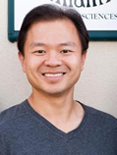
The QX100™ Droplet Digital System Enables Sangamo BioSciences to Accurately Detect Rare Mutations
Hercules, CA — October 22, 2012 — Bio-Rad Laboratories, Inc. today announced that its QX100 Droplet Digital PCR (ddPCR™) system enabled researchers at Sangamo BioSciences, Inc. to generate highly precise and reproducible data that puts the company one step closer to identifying a functional cure for HIV.
“The QX100 system allowed us to easily, accurately, and reproducibly measure low-copy events in genomic DNA,” said Dr. Gary Lee, senior scientist at Sangamo BioSciences. “ddPCR technology gave us confidence in our results, which is critical in advancing any program.”
Sangamo BioSciences utilizes a proprietary zinc-finger DNA-binding protein (ZFP) technology to modify the CCR5 gene, which encodes a major cell-surface co-receptor used by HIV to enter and infect CD4+ cells. The company engineered gene-editing ZFP nucleases (ZFNs) to permanently disrupt CCR5 in the immune cells (CD4+ T-cells) of HIV-positive (HIV+) patients, making these cells resistant to infection and thus potentially able to control the virus upon re-infusion into the patient. This revolutionary treatment employs each patient’s own immune cells as an alternative to drug therapy.
Available data from HIV+ subjects in trials to date suggest
that integration of HIV DNA into the host cell's genome is a rare event, occurring in only one cell per 1,000–100,000 CD4+ T-cells in peripheral blood. This apparently low level of HIV DNA in the CD4 compartment is known to sustain a low level of viral replication, especially in lymphoid tissues, even when free virus in the periphery has been eliminated by drug therapy. Therefore, one of the major challenges in Sangamo’s research was to determine a way to measure the level of HIV DNA in a subject and thereby evaluate the effectiveness of the new therapy. Although real-time quantitative PCR (qPCR) is an effective technology for gene expression analysis, imperfect amplification efficiencies and the necessity of establishing a standard curve prevent qPCR from delivering the precision and sensitivity needed to detect rare target DNA sequences.
Droplet Digital PCR technology provides an absolute measure of target DNA and RNA molecules, offering far greater sensitivity, reproducibility, and precision than qPCR. The QX100 system partitions samples and reagents into 20,000 droplets, with target and background DNA randomly distributed among them. This partitioning reduces background interference, allowing for more reliable and sensitive measurement of single copies of a target sequence (with abundances as low as 0.0001% of background) within a complex sample. Due to the digital nature of the assay and the fact that no standard curve is required, ddPCR can discriminate differences in target DNA concentrations as low as 10%.
According to Dr. Lee, at low copy numbers in two separate assays, real-time PCR results indicated a tenfold difference, making it difficult to determine whether the data reflected experimental variation or biological reality. With ddPCR technology, the difference was shown to be only twofold.
“That’s data we can really trust,” said Lee.
The company is currently conducting two phase 2 clinical trials in HIV+ patients. The QX100 system will be instrumental in allowing Sangamo BioSciences to determine the effectiveness of its therapy in reducing HIV levels. Thus far, the clinical data demonstrate a statistically significant relationship between the number of modified T-cells and a reduction in viral load during an interruption of antiviral treatment.
“We have been able to demonstrate that the QX100 system is the technology of choice when it comes to rare-event detection applications, particularly in clinical studies,” said Dr. Lee.
For further details about the QX100 Droplet Digital PCR system, please visit http://bit.ly/ddPCR_QX100. To learn more about how Sangamo scientists employed ddPCR to measure the efficacy of their functional cure, please read the story at http://bit.ly/Sangamo_Story.
About Bio-Rad
Bio-Rad Laboratories, Inc. (NYSE: BIO and BIOb) has remained at the center of scientific discovery for more than 50 years, manufacturing and distributing a broad range of products for the life science research and clinical diagnostic markets. The company is renowned worldwide among hospitals, universities, major research institutions, as well as biotechnology and pharmaceutical companies for its commitment to quality and customer service. Founded in 1952, Bio-Rad is headquartered in Hercules, California, and serves more than 100,000 research and industry customers worldwide through its global network of operations. The company employs over 7,100 people globally and had revenues exceeding $2 billion in 2011. For more information, visit www.bio-rad.com.
This release contains certain forward-looking statements within the meaning of the Private Securities Litigation Reform Act of 1995 and Section 21E of the Securities Exchange Act of 1934. Forward-looking statements generally can be identified by the use of forward-looking terminology such as, “believe,” “expect,” “may,” “will,” “intend,” “estimate,” “continue,” or similar expressions or the negative of those terms or expressions. Such statements involve risks and uncertainties, which could cause actual results to vary materially from those expressed in or indicated by the forward-looking statements. For further information regarding the Company's risks and uncertainties, please refer to the “Risk Factors” in the Company’s public reports filed with the Securities and Exchange Commission, including the Company’s most recent Annual Report on Form 10-K, Quarterly Reports on Form 10-Q and Current Reports on Form 8-K. The Company cautions you not to place undue reliance on forward-looking statements, which reflect an analysis only and speak only as of the date hereof. Bio-Rad Laboratories, Inc., disclaims any obligation to update these forward-looking statements.
For more information contact:
Richard Kurtz
Bio-Rad
510-741-5638
Richard_Kurtz@bio-rad.com
Ken Li
Chempetitive Group
312-997-2436 x 112
kli@chempetitive.com
